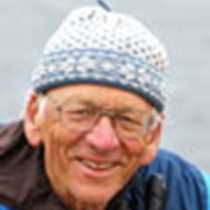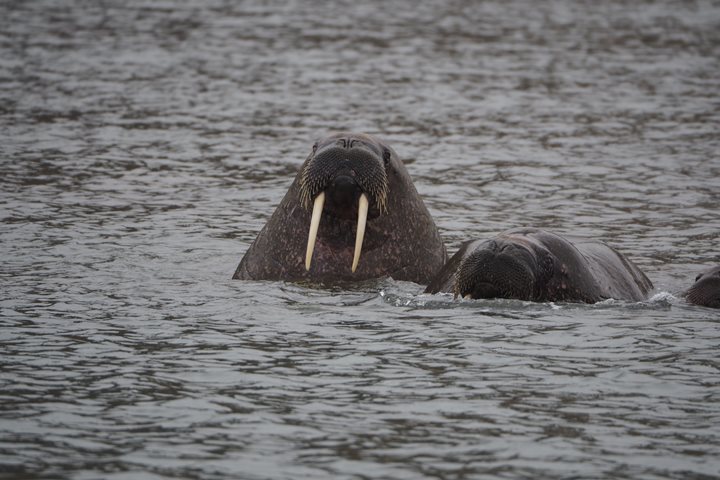During the night we set a course that took us into the passage between northeastern Spitsbergen and the large island of Nordaustlandet. Hinlopen Strait is one of the passages of the “east side” of Svalbard between the many islands on this more remote area of the archipelago. Thick fog continued all night long and was engulfing the ship when we awoke. Although we could not make out what was surrounding us, there were numerous birds on the waters we were slowly passing through. Our destination for just after breakfast was announced as Kapp Fanshawe, a cliff section along the northeastern part of Spitsbergen Island. However, it was not until we got further along that we began to realize what we were about to experience. The numbers of Brunnick’s Guillemots continued to increase as flocks scattered trying to take off, which was difficult for them due to the flat calm wind conditions. Birds fluttered off into the featureless fog. But soon we could hear a chatter, becoming a din of noise and then through the fog appeared the vertical cliffs used by the nesting birds.
On deck we could see thousands of birds on the cliffs, flying through the fog, and on the water. The captain moved the ship slowly and carefully toward the base of the cliff, and we could easily see the birds sitting on the small ledges. Birds were also sitting on snow patches waiting for it to melt before they could lay their single egg. These 250m cliffs were nesting sites for about 3000 birds—an impressive sight. We slowly progressed down the base of the cliff and were able to see most of the main nesting area. As the ship moved away from the cliff we moved inside to warm up and download all of the hundreds of photos.
Through the day we progressed southward in Hinlopen Strait but the fog continued to limit visibility to a few hundred meters all around. But vigilance was continued on the bridge searching for wildlife. Seals were occasionally spotted in the water and on the variable-sized ice floes. At one point in the late afternoon we discovered a patch of clear and blue sky at the end of a fjord. Scanning the remains of the shore fast ice we saw numerous seals but no predators.
Finally, as Recap began the fog lifted and we could see the shoreline of Nordaustlandet and scattered ice floes. During dinner the ship turned into Whalenburgfjord where there was a large mass of fast ice. Finally luck smiled on us and a couple distant polar bears were spotted.
Coming out on deck we could see distant seals and with some effort a couple bears could also be seen. Then as we moved toward one of the distant bears it actually started moving toward us. For the next hour we were treated to a fabulous and amazing experience. The young bear, maybe four years old, found the remains of a dead bird. Right in front of the ship it completely consumed what was left and then walked right over to the bow of the ship and then along both sides of the ship. The captain had quietly parked the ship at the edge of the fast ice when the bear was some distance away. The bear became curious and we became equally entranced by the curiosity of the bear. Thousands of images were taken as everyone crowded to the bow. The bear then decided to march slowly off after deciding we were merely admiring it. We then celebrated throughout the ship of our good fortune to finally view the majestic beast of the arctic pack ice.







